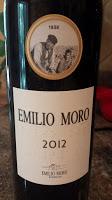 Through the power of web technology, last week I participated in a presentation by winemaker José Moro of Emilio Moro Winery on Ribera del Duero and a trio of their Tinto Fino (Tempranillo) wines. The video exchange started with Moro discussing the family history of the winery that his Grandfather Emilio Moro Sr. started almost a century ago. He selected the best sites on his land in Pesquera de Duero and grafted a unique clone of Tempranillo called Tinto Fino. This clone had several advantages which included smaller berry size and looser clusters. In 1932, Jose's Father Emilio was born and was the same year that Emilio Sr. planted the Finca Resalso vineyard. José was raised in the vineyard and the winery and in 1987-1988 he and his brother Javier, invested to create the Emilio Moro brand. Since that decision, the winery has received numerous awards and 90+ ratings.
Through the power of web technology, last week I participated in a presentation by winemaker José Moro of Emilio Moro Winery on Ribera del Duero and a trio of their Tinto Fino (Tempranillo) wines. The video exchange started with Moro discussing the family history of the winery that his Grandfather Emilio Moro Sr. started almost a century ago. He selected the best sites on his land in Pesquera de Duero and grafted a unique clone of Tempranillo called Tinto Fino. This clone had several advantages which included smaller berry size and looser clusters. In 1932, Jose's Father Emilio was born and was the same year that Emilio Sr. planted the Finca Resalso vineyard. José was raised in the vineyard and the winery and in 1987-1988 he and his brother Javier, invested to create the Emilio Moro brand. Since that decision, the winery has received numerous awards and 90+ ratings. José also spent a considerable amount of time during the web meeting discussing Ribera del Duero and the family's vineyards. Today Spain consists of 70 AVAs, but in 1925, Ribera became that country's third. It has a continental climate with long cold winters; hot, dry summers; and a sharp diurnal temperature swing between summer days and nights. Ribera contains three distinct elevation zones starting with the Low Plains (up to 750 meters) leading to the Slopes (750-850m), and ending at the Plateau (850-1,600m). In fact, this Plateau region contains the highest vineyards in Spain. There are also three types of soil spread through these elevation zones. According to José Moro, the chalky soils provide elegance and complexity; the clay soils structure and character; and the stoney soils maturity and sweetness.

We then moved on to sample three wines that were provided to the participants beforehand. Notice how the unique labels honor the family's history.
Finca Resalso 2014 ($14.99, 13.5%) - 100% Tinto Fino (Tempranillo); aged 4 months in 100% French oak barrels. Even though this wine is named after the vineyard, it is composed of grapes from younger vines (5-12 years old) planted throughout various vineyards and represents all elevations and soil types. The wine starts with ripe dark fruit aromas, some dustiness on the palate integrates with the fresh fruit; solid acids and easy tannins. Very approachable and quite the value.

Emilio Moro 2012 ($24.99, %) - 100% Tinto Fino (Tempranillo); composed of grapes from a selection of mid-aged vineyards (15 to 25 years) representing their most important soil types. 50% of the grapes were harvested from vines planted in chalk soil, then aged 12 months in French oak; whereas the other 50% was harvested from vines planted in clay soil and then aged 12 months in American oak. Moro noted that the French oak - chalk soil combination provides finesse and the American oak - clay soil provides more structure. The result is dark fruit - blackberries - more spice and leather on the palate; but silky texture and rich tannins & acids; a solid, complex and enjoyable wine.

Malleolus 2011 ($44.99, %) - 100% Tinto Fino (Tempranillo); Malleolus translates from Latin as majuelo, which is the name used in Pesquera de Duero for a small vineyard. This wine is an expression of the oldest vines (25 and 75 years old) and aged 18 months in 500 liter French oak barrels. This is an intense wine, both earthy and fruity (black fruit - dried cherries) with spices, leather, and chewy tannins. Simply fantastic.
